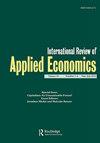Sectoral wage share and its decomposition in China
IF 1.6
Q3 ECONOMICS
引用次数: 1
Abstract
ABSTRACT This paper investigates sectoral contributions to the trend of national wage share, or the labor income share, during 2000–2014 in China. I apply the logarithmic mean Divisia index (LMDI) decomposition, the method widely used in energy studies, to decompose the trend of the wage share. At a sectoral level, with rapid structural transformation, structural change negatively impacted the wage share through the between-sector effect – the structural and price effects – mainly from agriculture. This result confirms Arthur Lewis’s hypothesis that structural transformation has a negative contribution to the wage share. At a national level, when the wage share declined before 2008, the between-sector effect was as significant as the within-sector effect – the wage and productivity effects. After 2008, the within-sector effect directed the increasing wage share trend. This implies that although structural transformation matters to the wage share in a large developing country like China, a wage-productivity nexus has been more influential and determined the increasing trend of the wage share since 2008.中国行业工资份额及其分解
摘要本文调查了2000-2004年中国各部门对国民工资份额或劳动收入份额趋势的贡献。我应用对数平均Divisia指数(LMDI)分解,这是能源研究中广泛使用的方法,来分解工资份额的趋势。在部门一级,随着结构的快速转型,结构变化通过部门间效应——主要来自农业的结构和价格效应——对工资份额产生了负面影响。这一结果证实了Arthur Lewis的假设,即结构转型对工资份额有负面贡献。在国家层面,当工资份额在2008年之前下降时,部门间效应与部门内效应(工资和生产力效应)一样显著。2008年后,行业内效应引导了工资份额的增长趋势。这意味着,尽管结构转型对中国这样的发展中国家的工资份额很重要,但自2008年以来,工资与生产力的关系更具影响力,并决定了工资份额的增长趋势。
本文章由计算机程序翻译,如有差异,请以英文原文为准。
求助全文
约1分钟内获得全文
求助全文
来源期刊

International Review of Applied Economics
ECONOMICS-
CiteScore
4.30
自引率
4.50%
发文量
37
期刊介绍:
International Review of Applied Economics is devoted to the practical applications of economic ideas. Applied economics is widely interpreted to embrace empirical work and the application of economics to the evaluation and development of economic policies. The interaction between empirical work and economic policy is an important feature of the journal. The Journal is peer reviewed and international in scope. Articles that draw lessons from the experience of one country for the benefit of others, or that seek to make cross-country comparisons are particularly welcomed. Contributions which discuss policy issues from theoretical positions neglected in other journals are also encouraged.
 求助内容:
求助内容: 应助结果提醒方式:
应助结果提醒方式:


